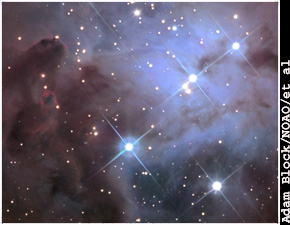The sun is the main source of all life on our planet. Many millions of years ago the sun came to life as matter
possibly from an antient gas cloud collapsed and formed our early solar system. Heavier element traveled tword the center
while lighter elements remained to the outer reaches. As the matter became more and more dense and the young protosun began
to heat up. As time went by our sun grew in activity and soon became the object we see today.
The temperature of the sun varies greatly with a core of about 27 million degrees Fahrenheit to 10,500 degree Fahrenheit
at the photosphere. One of the most promenent features on the surface is the appearance of sunspots which increase and decrease
on an average of an 11 year cycle. Sunspots are often associated with interference in radio and television signals. And although
when observed may look like as if part of the sun has burnt out, but are actually areas of concentrated magnetic activity
only about 3,600 degrees cooler than the photosphere.
Please use caution if you observe
the Sun. Looking through the lens of a telescope at the Sun will cause blindness

